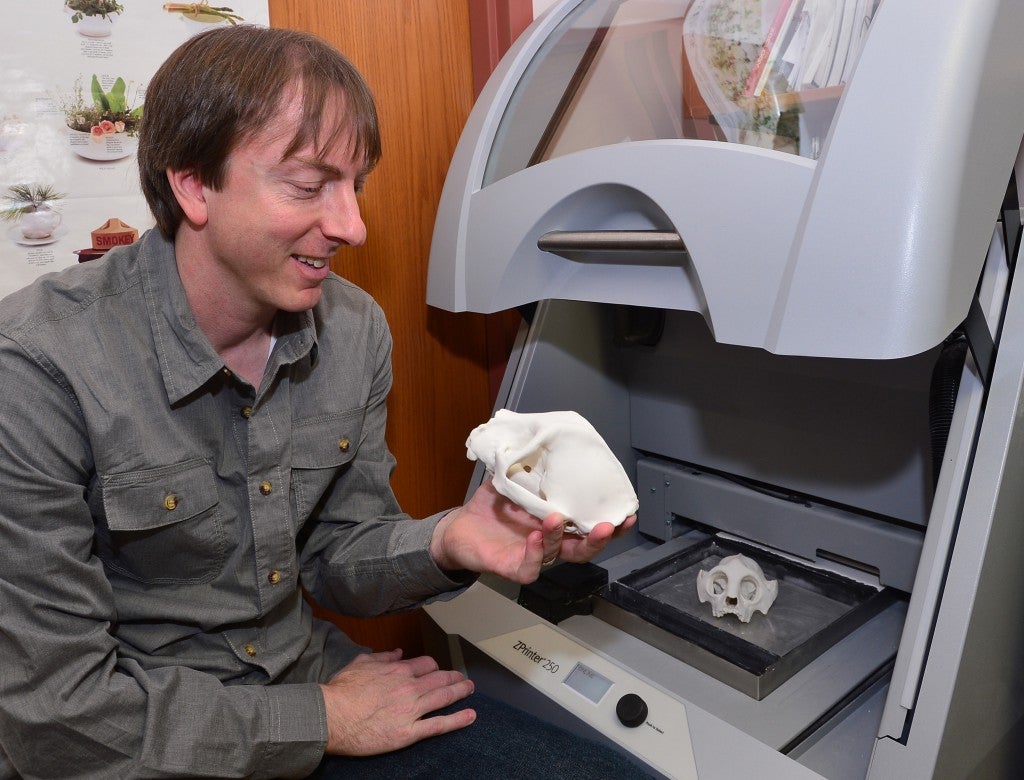Thursday, Jan. 9, 2014
[social_share/]
HUNTINGTON, W.Va. – As a biological anthropologist and assistant biology professor at Marshall University, Dr. Paul Constantino studies human evolution. His research focuses on how the skull and teeth have developed and how diet has influenced that development.
The shelves of his office are lined with life-size skull models illustrating the range of human evolution and his lab is filled with experiments designed to measure things like the force required to crack nuts and the jaw motions of giant pandas as they chew bamboo.
Ironically, perhaps, for someone studying and teaching about humans who lived tens of thousands of years ago, Constantino is using one of today’s hottest technologies in his lab and classroom.
He recently bought a state-of-the-art 3-D printer to give students in his human anatomy courses hands-on access to replicas of specimens they are studying.
He says, “We purchased the printer so we could make reproductions of specimens at the size we need to inspect them. For example, some of the teeth we are examining are tiny, almost microscopic, so they are very difficult to see. Now we can print a model of that tooth that’s large enough to handle and shows all the detail, right down to the ridges and grooves on the surface of the actual specimen.”
Or, he adds, perhaps the actual specimen they want to see is one-of-a-kind and in a collection on the other side of the world. All Constantino’s team needs is a 3-D data file of the object and they are able to print a realistic model they can hold in their hands right here in Huntington.
Constantino said they are continuing to expand their capabilities and have recently ordered a portable 3-D scanner to complement the printer.
“We will be able to take the 3-D scanner out in the field—to a museum or archeological site for example—scan a specimen, come back to the lab and print a reproduction of it that we can study,” he added. “We will also be able to scan moving objects, like a person’s head while they are talking, and capture and print a particular expression in 3-D.”
Constantino is working to get the word out that access to the equipment is available to other departments across the university. He said he can envision teaching and research applications in a number of fields, including engineering, science, the arts and medicine.
“We want to make sure this valuable tool is used as much as possible. The equipment has to be run regularly to keep it in working order, so we are making it available to the university community,” he said. “We can provide scaled-up versions of whatever faculty and students might be studying—molecules or microbes, for instance.
“The printer is great for creating 3-D models of almost anything, including design prototypes, maps and anatomical structures. All we really need to print a model is a 3-D image. We can use CT or laser scans, even data from confocal microscopes. Anything like that will work. We can even do color models.”
For more information, contact constantinop@marshall.edu.
Constantino joined the faculty at Marshall in 2010. Prior to that, he was a postdoctoral scientist at George Washington University.
He has a bachelor’s degree in biology from St. Michael’s College, a master’s degree in anthropology from Florida Atlantic University and a doctorate in hominid paleobiology from George Washington University. In April, he was honored with the Marshall University Distinguished Artists and Scholars Award, which recognizes achievements in the fields of artistic and scholarly activity.
Contact: Ginny Painter, Communications Director, Marshall University Research Corporation, 304.746.1964